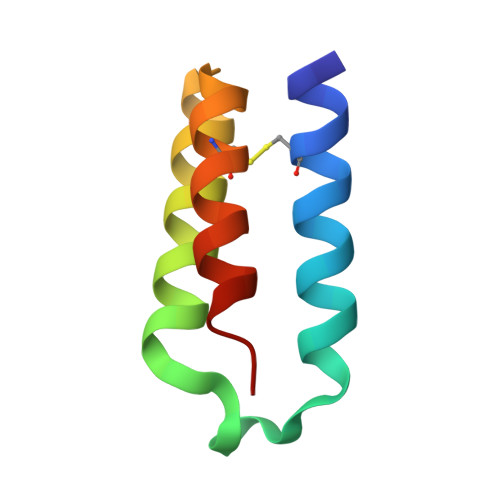Modulating metal-centered dimerization of a lanthanide chaperone protein for separation of light lanthanides.
Larrinaga, W.B., Jung, J.J., Lin, C.Y., Boal, A.K., Cotruvo Jr., J.A.(2024) Proc Natl Acad Sci U S A 121: e2410926121-e2410926121
- PubMed: 39467132
- DOI: https://doi.org/10.1073/pnas.2410926121
- Primary Citation of Related Structures:
9C8W, 9C8X, 9C8Y, 9C8Z, 9C90 - PubMed Abstract:
Elucidating details of biology's selective uptake and trafficking of rare earth elements, particularly the lanthanides, has the potential to inspire sustainable biomolecular separations of these essential metals for myriad modern technologies. Here, we biochemically and structurally characterize Methylobacterium ( Methylorubrum ) extorquens LanD, a periplasmic protein from a bacterial gene cluster for lanthanide uptake. This protein provides only four ligands at its surface-exposed lanthanide-binding site, allowing for metal-centered protein dimerization that favors the largest lanthanide, La III . However, the monomer prefers Nd III and Sm III , which are disfavored lanthanides for cellular utilization. Structure-guided mutagenesis of a metal-ligand and an outer-sphere residue weakens metal binding to the LanD monomer and enhances dimerization for Pr III and Nd III by 100-fold. Selective dimerization enriches high-value Pr III and Nd III relative to low-value La III and Ce III in an all-aqueous process, achieving higher separation factors than lanmodulins and comparable or better separation factors than common industrial extractants. Finally, we show that LanD interacts with lanmodulin (LanM), a previously characterized periplasmic protein that shares LanD's preference for Nd III and Sm III . Our results suggest that LanD's unusual metal-binding site transfers less-desirable lanthanides to LanM to siphon them away from the pathway for cytosolic import. The properties of LanD show how relatively weak chelators can achieve high selectivity, and they form the basis for the design of protein dimers for separation of adjacent lanthanide pairs and other metal ions.
- Department of Chemistry, The Pennsylvania State University, University Park, PA 16802.
Organizational Affiliation:

















